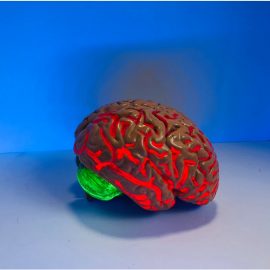

This article is an excerpt from the Shortform book guide to "If You Tell" by Gregg Olsen. Shortform has the world's best summaries and analyses of books you should be reading.
Like this article? Sign up for a free trial here.
How did Shelly Knotek abuse her daughters? How did the young victims escape the horrific abuse?
If You Tell by Gregg Olsen explores the various ways in which Shelly Knotek abused her victims along with her husband Dave’s help. Her first victims were her three daughters—Nikki, Sami, and Tori—and it took them years to finally get the help they needed to escape.
Keep reading to learn what Shelly Knotek’s daughters had to endure during their childhood.
How Shelly Knotek Abused Her Daughters
As Olsen explains, Shelly Knotek’s daughters began experiencing abuse at a young age by their mother. Nikki, the oldest, has a memory from when she was very young in which she woke suddenly to find a pillow pressed over her face, suffocating her. She screamed and her mother showed up instantly to comfort her. As she consoled her, Shelly insisted that Nikki’s perception of someone putting a pillow over her face had been a dream, observing Nikki’s reaction with interest. Nikki knew it wasn’t a dream but backed down in the face of her mother’s insistence. When her third and final husband, Dave, was around and not at work, he either watched passively or participated as Shelly ordered him to.
Shelly used extremely harsh punishments for even the slightest misbehaviors. She beat her children and husband with implements from around the house and took pleasure in their pain. She also locked them in closets or out of the house, forcing them to sleep outside. Frequently, the children didn’t know what they were being punished for, but she told them they were bad, ungrateful, and spoiled. However, she also showed great affection toward the children on some days. Nikki never knew what would set her mother off and bring on more abuse.
Nikki received the brunt of the abuse for most of her childhood. Shelly would punch her, throw her into walls, and beat her with a phone cord. Nikki hid the bruises on her legs under tights and never told anyone what was going on at home. She didn’t want the attention it would bring, and no one ever asked her about violence at home. As an adult, Nikki suggested that she was partly at fault for the violence she experienced because of her attempts to get away from her raging mother. Later, when Nikki moved out and the abuse fell on the younger two sisters, they, too, kept it a secret for fear of what would happen to their family if their mother got caught.
Shelly began restricting the children’s bathroom and shower use. The kids had to get her permission to use the restroom, and they were often not allowed to bathe for long periods of time, which caused embarrassment and alienation at school.
Shelly enjoyed causing pain, humiliating, and psychologically manipulating her daughters, and occasionally the abuse resulted in severe injuries. Once, as she was chasing Nikki through the house trying to beat her, Shelly shoved Nikki through a plate glass door, causing her to get cuts all over her body. Shelly immediately became apologetic and affectionate, putting her daughter in a warm bath and afterward taking her out to dinner and a stylist. She didn’t take Nikki to the hospital because, according to Sami, she wouldn’t be able to explain all the bruises and other injuries on Nikki’s body.
| A Comparison: Dave Pelzer’s A Child Called It In many ways, the Knotek case resembles the child abuse inflicted on Dave Pelzer as described in his book A Child Called It. Like Shelly Knotek, David’s mother meted out brutal punishments for slight or imagined misbehaviors, and she generally targeted one child at a time. David was primarily targeted, and his brothers—particularly his brother Richard—collaborated with their mother, even making up stories at times to get him punished (a step beyond Sami’s occasional tattling). Once David was rescued from the home, Richard became their mother’s new target, just as Sami and later Tori did when their mother’s previous target escaped. Unlike Dave Knotek, David Pelzer’s father didn’t actively participate in the abuse, and, in the beginning, he attempted to deter it, though he eventually gave up. Still, in both cases, the men saw the horrific abuse being carried out against helpless children and failed to rescue them. Like Shelly, David’s mother sometimes severely injured him in the course of her abuse, at one point stabbing him in the stomach but refusing to take him to the hospital to have the injury treated. Also like Shelly, these more severe injuries were followed by brief periods of affection and caring, after which the abuse resumed. While Shelly didn’t drink, David’s mother was an alcoholic who carried out most of her abuse when drunk, but both women centered their violence around the idea that their victims were bad and deserved the punishments. David’s mother and Shelly Knotek’s enjoyment of the pain and humiliation they caused their victims is characteristic of sadistic tendencies. Sadistic tendencies can co-occur with psychopathy and antisocial personality disorder, but they differ in that sadism is characterized by the enjoyment of inflicting pain and humiliation for its own sake, while the abuse inflicted by those with antisocial personality disorder is usually a means to achieving a goal—such as silencing a victim or enabling other types of abuse (such as sexual abuse). While previously recognized as a distinct disorder, sadistic personality disorder is no longer in the DSM and is usually considered to be an antisocial trait. However, some experts suggest it should be considered separately since it appears to be more treatable than antisocial personality disorder. |
Sami saw these punishments and felt guilty that they were only being directed at Nikki—who she knew didn’t deserve them—and not at herself. Sami was abused as well, but she was often able to mitigate it by not resisting and by ingratiating herself with their mother. There were also some instances when Sami told on Nikki to escape their mother’s wrath, but the sisters loved each other and neither wanted the other to suffer.
Since Tori was so much younger, she was generally spared from the abuse until the older girls moved out. However, there were warning signs even when Tori was an infant. When she was born, Shelly claimed Tori was a premature baby—which was false—and that she had heart problems. She was put on a heart monitor at home. Every night, the alarm of the heart monitor would go off, and Sami and Nikki would rush downstairs to check on their sister and find Shelly holding the baby lovingly, assuring them that, “She’s fine now.” Shelly seemed to enjoy the attention. One night, Nikki came down before the alarm went off and found her mother standing over the baby holding a pillow onto her face. A surprised Shelly said again, “She’s fine now.”
How Nikki and Sami Got Away
Nikki graduated from high school in 1993, and she desperately wanted to go to college and move away, Olsen explains. She enrolled in community college, but her mother began sabotaging her, taking away her school clothes and refusing to give her money for the bus so she had no transportation. One day when Shelly was abusing her, Nikki resisted and knocked her mother to the ground, to Shelly’s astonishment. Having someone fight back for the first time ever made Shelly change tactics: She’d remove Nikki from her presence.
(Shortform note: Shelly’s surprise at Nikki’s reaction—and her surprise at Kathy’s death—may be related to a reduced ability to understand the consequences of her actions. Psychopaths process reward and punishment differently than other people, which can lead them to persist in behaviors that result in punishment—like continuing to commit crimes after being released from prison. But in Shelly’s case, finding that her victim was no longer compliant seemed to prompt her to send the victim away, perhaps so she could focus on the less defiant ones.)
Shelly told Nikki, who was 20 at that point, that Sami didn’t want her living there anymore and that she needed to leave. She said she was sending Nikki to stay with her aunt and uncle for two weeks, but Nikki managed to keep from going back home except for visits. She lived in extreme poverty for a while but eventually got a job and put herself through college. Tori, who was only six and idolized Nikki, was hurt by her absence, and Shelly convinced her that Nikki didn’t love her and had abandoned them. Tori’s sadness at Nikki’s departure also led Shelly to beat Tori for the first time ever. Sami understood why Nikki had left and secretly stayed in contact with her.
Sami became the focus of Shelly’s abuse. As far as she could tell, Tori was largely immune from the mistreatment, so she felt like, if she escaped, Tori would still be OK. She planned an escape her senior year of high school, in 1997: She sneaked away from the house and hid from her mother, first at her friend’s house, then at her boyfriend’s. Her boyfriend’s mother then drove her to stay with her grandmother Lara. Shelly and Dave made many attempts to get her to come back home. Eventually, she agreed to come back on the condition that they pay for her college. She made it clear to Shelly that she knew what had happened to Kathy and used that as leverage.
(Shortform note: Because they’re usually dependent on their parents for financial and other types of support, it can feel impossible for a child to escape an abusive parent. Leaving an abusive home at any age requires resources, which is a major reason why many abuse victims can’t leave. Nikki had to go through a long period of poverty, and Sami was coerced into returning home by the promise of her college being paid for, but both eventually had the mental and emotional fortitude to escape.)
That fall, Sami went to college, living on campus but coming home for visits on weekends and holidays. While Sami was away at college, Shelly began abusing Tori as she’d done with the other two girls. Tori quickly learned to do whatever Shelly told her immediately and without protest to avoid worsening the situation. Whenever Sami asked Tori how she was, Tori said she was fine, so Sami believed she wasn’t being abused.
The Fate of Shelly Knotek’s Daughters
According to Olsen, the first time anyone in the family went to the police about the Knoteks’ activities was in 2001, while Ron Woodworth was still alive. Nikki, then 26, had gone to stay with her grandmother Lara, and the second day there, Nikki told her what happened to Kathy Loreno. Lara was shocked, but she knew Nikki was honest and believed her.
They reported the information to the police and faxed a detailed account of what happened to Deputy Jim Bergstrom of the Pacific County Sheriff’s Department. Nikki thought things would change, but after the police were unable to reach Sami—then 22 and still away at college—to verify Nikki’s story, they didn’t follow up on the case. When Lara followed up months later to ask about Kathy’s case, Deputy Bergstrom told her it had gone cold, that he was in the middle of a big trial and would get back to work on it when he could.
The weekend after Ron died, Shelly allowed Tori to go spend the weekend with Sami in Seattle. Together they met Nikki for lunch. It was the first time Nikki and Tori had seen each other in seven years. Tori was scared to see her sister again after everything Shelly had said about her, but it turned out to be a wonderful reunion, and Tori realized how badly she’d missed Nikki. She also realized how much her mother had manipulated her into hating her oldest sister.
Later during that weekend, Sami and Tori were folding laundry when Sami casually shared that their mother used to dump all her clothes out on the floor in the middle of the night and make her match everything up. After a pause, and to Sami’s dismay, Tori said their mother did that to her, too. They kept talking, and Sami realized Tori was being subjected to the same abuse she and Nikki experienced. Sami asked about Ron and realized Shelly had done the same thing to him that she’d done to Kathy. Tori then revealed that she suspected Ron was dead.
Sami told Nikki, and they decided they had to get Tori out of that home. In August of 2003, the two of them went to speak with Deputy Bergstrom again. Unlike last time, their concerns were taken seriously now—though it was too late to save Ron.
A few days later, Tori was removed from the home by Child Protective Services (CPS). Shelly was furious and panicked, and she sent Dave to go see Tori at CPS, but he couldn’t find her. He went to the police station instead. They asked him to consent to an interview, and Dave, still believing that neither he nor his wife had ever abused the girls, agreed. He didn’t expect them to ask about Ron and Kathy, but they did, and, eventually, he fell apart and confessed to the disposal of Ron and Kathy’s remains. As a result, though he’d refused to incriminate her, Shelly was finally arrested on August 8, 2003—Kathy Loreno’s birthday.
Dave Knotek pleaded guilty to the second-degree murder of Shane Watson, the unlawful disposal of human remains, and rendering criminal assistance. Shelly Knotek took an Alford plea, pleading guilty to second-degree murder and manslaughter while maintaining her innocence.
Dave was sentenced to 15 years in prison. He was released in 2016. Sami and Tori have come to forgive him and have accepted him back into their lives, though Nikki can’t bring herself to do so. Shelly was sentenced to 22 years in prison, and at the time of the book’s publication, was set to be released in 2022 at age 68.

———End of Preview———
Like what you just read? Read the rest of the world's best book summary and analysis of Gregg Olsen's "If You Tell" at Shortform.
Here's what you'll find in our full If You Tell summary:
- The true story about abusers and murderers Shelly and Dave Knotek
- The events leading up to Shelly and Dave's arrests and convictions
- A look into the psychology of abuse and psychopathy






